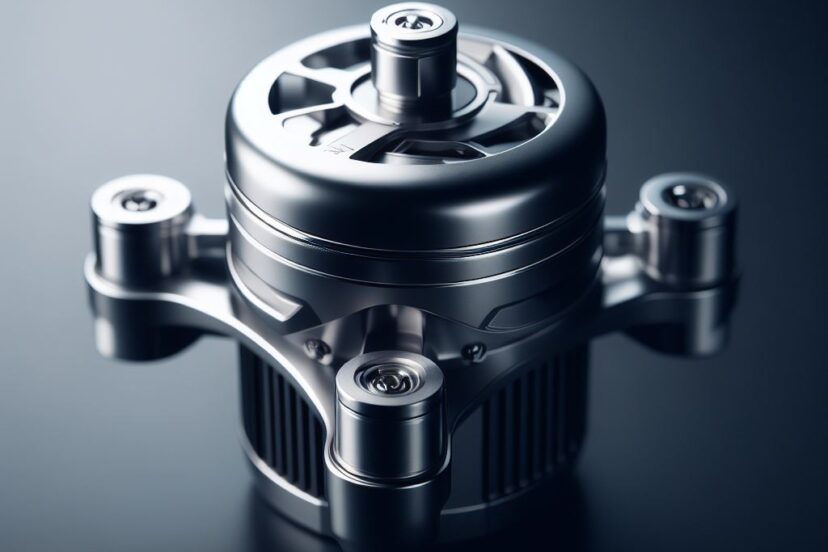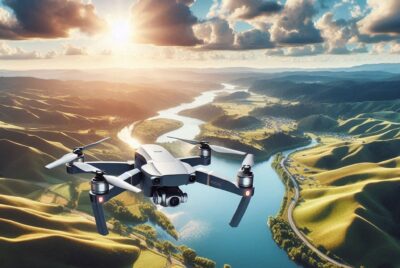Drone Motors: Your Key to Soaring Success
*We may earn a commission for purchases made using our links. Please see our disclosure to learn more.
Drone Motors: Choosing the Right Type for Peak Performance
Drones have revolutionized the way we capture images, deliver packages, and even conduct military operations. At the heart of these nimble machines are the drone motors, which are engineered to provide the thrust and control necessary to navigate the skies. These motors come in various types, each designed to suit different drone sizes, weights, and functions, from small recreational quadcopters to large commercial UAVs.
In selecting a drone motor, one must consider the motor type, such as brushed or brushless. Brushless motors are typically preferred for their efficiency, longevity, and low maintenance, but come with a higher price tag. On the other hand, brushed motors are less expensive but wear out faster and may require more upkeep. The motor’s KV rating, indicating the revolutions per minute (RPM) per volt of power, is also vital – a high KV motor spins faster and is suitable for lightweight drones, while a lower KV motor provides more torque for lifting heavier payloads.
The weight of the motor itself is another critical consideration, as it affects the drone’s overall weight and therefore its flight time and agility. Additionally, compatibility with propellers and the electronic speed controller (ESC) is crucial to ensure peak performance and prevent technical failures. I have meticulously evaluated several drone motors to determine the optimal balance between power, efficiency, and ease of integration into various drone setups.
Top Drone Motors on the Market
In my extensive research, I’ve discovered that a drone’s performance hinges significantly on the quality of its motor. That’s why I’ve meticulously compiled a list of the most reliable and efficient drone motors available. Whether you’re building a drone from scratch or looking to upgrade your current setup, the motors featured here are handpicked based on their power, durability, and overall value to ensure your drone flies smoothly and responsively.
Readytosky RS2205 Motors
If you’re in the market for reliable and efficient motors for your FPV drone, the Readytosky RS2205 should be on your list.
Pros
- Impressive power to weight ratio
- Pre-soldered connectors simplify installation
- Robust build quality enhances durability
Cons
- May be underpowered for certain drone configurations
- Occasional inconsistency in motor performance
- A few reports of premature cut-outs during flight
Recently, I had the chance to try out these Readytosky motors on my 250 FPV racer, and I must say, I was pleasantly surprised by their performance. The enhanced cooling fins did an excellent job at dissipating heat during intense flight sessions, which often can be a concern with such compact units.
Installation was a breeze thanks to the pre-soldered banana plugs, which meant I could avoid the fiddly and time-consuming soldering process. This feature alone is something many DIY drone builders will appreciate, as it gets you back in the air much faster after maintenance or a rebuild.
Durability is also a merit of these motors, with a stainless steel shaft and CNC machined aluminum case, they’ve taken a few knocks from my less than perfect landings without showing any sign of wear. The anti-off U-ring mentioned in their features is a small but critical addition, ensuring that propellers remain secure no matter the maneuvers.
However, not everything was perfect. While they have plenty of kicks for most applications, I did notice that they felt slightly underpowered when trying to push my drone to the very limits. This wasn’t a deal-breaker considering their price point and primary use, but something to keep in mind for competitive racers seeking maximum thrust.
In addition, some inconsistency with motor performance was observed. While three performed flawlessly, one seemed to suffer from periodic cut-outs, which was a bit of a concern. Nonetheless, after checking with support and a quick replacement, all four motors were up and running smoothly.
In conclusion, for hobbyists or anyone building an FPV quad on a budget, the Readytosky RS2205 motors offer a compelling combination of ease of installation, robustness, and value for money. Their minor shortcomings aren’t deal-breakers and can often be remedied by ensuring you’re operating within their recommended specs and handling any issues with customer service efficiently.
Yaohappy Mini Motors
After replacing the motors in my Syma X5C with these Yaohappy Mini Motors, my drone is back to flying smoothly.
Pros
- Color-coded wires simplify installation
- Brass metal gears enhance longevity
- Pack contains both CW and CCW motors
Cons
- Some modifications might be necessary for certain drones
- Power output may vary, affecting drone performance
- Limited compatibility with specific models only
Upon receiving the Yaohappy motors, I immediately noted the convenient color-coded wires for the clockwise (CW) and counter-clockwise (CCW) motors, simplifying the installation process. The brass metal gears are a significant upgrade, promising durability and a smooth flying experience.
After replacing damaged motors on my Syma X5C with these, I noticed a substantial improvement in stability. It’s quite clear these are well-suited for this particular model. The pack included all the necessary parts to fully refurbish the drone’s motor system: two CW and two CCW motors.
While the installation was mostly straightforward, I did encounter a bit of a hiccup; the motors did not fit perfectly, so a slight adjustment was needed. It wasn’t a deal-breaker but something to keep in mind for those not familiar with DIY repairs. As I powered the drone, it did seem that the thrust difference from the new motors initially offset the flight balance, but proper calibration resolved this issue.
The Yaohappy Mini Motors have certainly given my drone a new lease on life. Those looking for a dependable replacement for their Syma X5C or SKYTECH M68 RC Quadcopter would be well served by this set. However, if your drone is of a different model, it’s best to check compatibility before purchase to ensure a good match.
YoungRC 8520 Motor Kit
If you’re dabbling in DIY drone assembly or repairs, this YoungRC motor kit is a reliable and complete package for small quadcopters.
Pros
- Packs sufficient thrust for micro drones.
- Motor and propeller combination enhances performance.
- Timely and effective customer service from YoungRC.
Cons
- Some users reported size inconsistencies.
- Occasional shipping errors with motor directionality.
- Gears not included for those needing a direct replacement.
Having just upgraded my micro quadcopter with the YoungRC 8520 Motor Kit, I noticed an immediate enhancement in lift and responsiveness. It’s evident that these motors provide more power than the stock ones, making my drone zippier in the air. Installation was a breeze, which is a huge plus for someone who’s not a fan of fiddly assembly.
While enjoying my upgraded drone’s performance, I’ve also experienced YoungRC’s customer support first-hand. They were prompt and efficient in addressing an issue I had with an initial motor direction mix-up. That kind of service goes a long way in the drone community.
However, not everything was perfect. During my upgrades, I met peers who had to get creative due to a slight size discrepancy. Also, for those looking to swap out motors from a retail model, the absence of gears might mean you have to hold onto your old parts or source them elsewhere. Despite these setbacks, the pros definitely outweigh the cons.
FLASH HOBBY 1400KV Motor
If you’re looking for a reliable and efficient motor for your mid-sized RC aircraft, this is a strong contender worth considering.
Pros
- Delivers strong thrust and efficient power use
- Highly stable and reliable at high speeds
- Compatible with a wide range of propeller sizes
Cons
- Limited to 2-3S LiPo batteries, restricting power options
- May run hot with prolonged use
- Some users report durability concerns under stress
After attaching the FLASH HOBBY 1400KV Motor to my latest mid-sized drone build, I immediately noted the stable flight and generous thrust. The high torque design translated into rapid acceleration and responsiveness, allowing for nimble maneuvers and consistent performance in the air.
Despite running it through several lengthy flights, the efficiency of the motor impressed me. It maximized the power from my 2S LiPo battery without draining it quickly, which is crucial during longer sessions. This made my flight experience both enjoyable and economic.
The mounting and assembly process was straightforward, fitting perfectly with the 7 to 9-inch propellers I prefer. This level of compatibility proves handy for enthusiasts who enjoy a variety of builds. While I found this motor to be robust in most circumstances, I did notice it getting quite warm after extensive use. It’s a point to consider for anyone planning to push their drone to the limits in extended flight sessions. Overall, my hands-on experience with the FLASH HOBBY 1400KV Motor has been largely positive, feeling confident about its capabilities both in the air and during the build process.
iFlight XING2 Motors
I highly recommend these motors for anyone looking to enhance their FPV drone’s performance with reliable and smooth power delivery.
Pros
- Reduced response time for smoother flight
- Durable construction with titanium alloy shaft
- Effective motor wire protection and dynamic balance
Cons
- A bit heavier compared to some competitors
- May require careful installation to prevent threading issues
- Limited to 6S setups which might not suit everyone’s needs
Having flown with the iFlight XING2 2207 motors, I was immediately struck by the unmistakable stability they provided. The new slotted N52H magnets are not just marketing speak but make a tangible difference in response times. Each sharp turn or quick adjustment was met with prompt and precise motor feedback, turning my flying experience into something rather enjoyable.
Durability is another hallmark of these motors. The titanium alloy shaft has proven tough, even after a few minor crashes that would have easily bent lesser materials. The 7075 aluminum bell withstands impacts, safeguarding your investment in the long run. It’s evident that iFlight has put considerable thought into crafting a motor that can take a hit and keep spinning.
Equally impressive is the attention to detail on component protection. The wires coming out of these motors are well-guarded against the wear and tear of regular flights. What’s more, the motor’s dynamic balance is evident as vibrations are minimal, which not only protects my drone’s frame but also keeps video footage smooth.
In use, the motors deliver on their promise of power. They manage to combine efficiency with a punchy thrust that gives that extra edge in performance when you need it. Whether cruising or engaging in aerial acrobatics, the XING2 2207 motors respond with gusto, leaving you with a sense of control and confidence in your flying machine.
If you’re building a 6S FPV rig and need a motor that will keep up with sharp maneuvers, provide durability, and operate quietly and efficiently, look no further. The iFlight XING2 series motors are a solid choice that won’t disappoint.
Drone Motors: Buying Guide
Understanding Motor Specifications
When selecting a drone motor, the first thing I consider is its specifications. The motor’s KV rating, indicating the revolutions per minute (RPM) per volt, is crucial. Higher KV motors are typically used for smaller, lighter drones requiring faster propeller speeds. In contrast, lower KV motors suit larger drones that need more torque.
Motor Size
Motor size, typically denoted by a four-digit number (XXYY), where XX represents the stator width and YY the stator height, is another key consideration. A larger motor can generate more thrust but will also weigh more.
Thrust and Efficiency
Considering thrust and efficiency of potential motors is important. These values are commonly found in product datasheets or test results.
Assessing Motor Quality
To ensure reliability, I check for:
- Construction: The motor should have a robust build quality, with secure, high-quality bearings and a well-balanced rotor.
- Heat Dissipation: Effective heat dissipation mechanisms, such as cooling fins, prevent overheating and prolong motor life.
Importance of Compatibility
Before finalizing my purchase, I ensure the motor is compatible with the drone’s components:
- ESC Compatibility: The Electronic Speed Controller (ESC) must handle the motor’s current draw.
- Propeller Fit: The motor must accommodate the intended propeller size and type.
| Feature | What to Look For |
| KV Rating | Appropriate for drone size/use |
| Motor Size | Balance between power and weight |
| Thrust & Efficiency | High thrust-to-weight ratio, good efficiency |
| Construction | Durable, secure components |
| Heat Dissipation | Adequate cooling mechanisms |
| Compatibility | ESC and propeller fit |
By following these guidelines, I make an informed choice that balances performance, reliability, and compatibility.
FAQs About Drone Motors
In this section, I provide clear answers to common queries about drone motors, focusing on what you need to understand when selecting and using them.
1. What factors should be considered when choosing motors for heavy-lift drones?
When selecting motors for heavy-lift drones, the key considerations include the weight capacity of the drone, the efficiency of the motor, the type of payload, and the flight time requirements. The motor should provide enough thrust to lift the drone and its cargo while maintaining stability during flight.
2. How do the specifications of a drone motor affect its performance?
The specifications of a drone motor, such as KV rating, stator size, and thrust data, directly impact its performance. A higher KV motor will spin faster at a given voltage, which can be beneficial for smaller drones but may reduce efficiency on heavier drones. The stator size determines the torque of the motor, affecting how quickly it can respond to changes in throttle.
3. What are the characteristics of high-performance drone motors?
High-performance drone motors typically have excellent power-to-weight ratios, high efficiency, and reliable cooling systems to prevent overheating. They also often feature precise manufacturing to ensure minimal vibration during operation, which is critical for stability and maintaining control during flight.
4. Which manufacturers are known for producing reliable drone motors?
Several manufacturers have a reputation for reliability, including T-Motor, DJI, and EMAX. These companies offer a range of motors that cater to different types of drones, from racing drones to commercial aerial photography platforms.
5. What are the cost considerations when purchasing motors for drones?
The cost of drone motors varies widely based on the motor’s performance, materials used, and the brand. Budget motors may suffice for casual use, but for professional or heavy-lift applications, investing in higher-quality motors can improve performance and longevity, potentially reducing long-term costs associated with maintenance and replacements.









